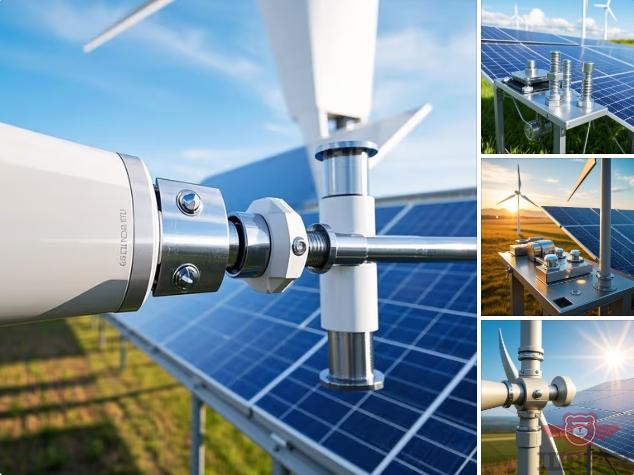Introduction
Fasteners, though small in size, are indispensable components in renewable energy projects. From securing solar panels to anchoring wind turbine blades, these components ensure structural integrity, durability, and efficiency. As the renewable energy sector continues to grow, the demand for high-quality fasteners that can withstand harsh environmental conditions has never been greater. This article explores the critical role of fasteners in renewable energy applications, focusing on material selection, installation methods, and industry standards.

1. The Importance of Fasteners in Renewable Energy Systems
Fasteners are the unsung heroes of renewable energy projects. In solar panel installations, they secure photovoltaic modules to mounting structures, ensuring stability even in high winds. In wind energy systems, fasteners hold together massive turbine components, including blades, towers, and nacelles. Without reliable fasteners, these systems would be prone to failure, leading to costly downtime and safety risks.
The choice of fasteners directly impacts the longevity and performance of renewable energy systems. For instance, in coastal areas, fasteners must resist corrosion caused by saltwater exposure. Similarly, in regions with extreme temperature fluctuations, fasteners must maintain their strength and integrity.
2. Material Selection for Fasteners in Renewable Energy
The material of a fastener determines its suitability for specific applications. Common materials include:
-
Stainless Steel: Known for its corrosion resistance, stainless steel is ideal for offshore wind turbines and solar farms in coastal regions.
-
Carbon Steel: Often used in structural applications, carbon steel fasteners are strong and cost-effective but may require coatings for corrosion protection.
-
Titanium: Lightweight and highly resistant to corrosion, titanium fasteners are used in high-stress environments, such as aerospace-inspired wind turbine designs.
-
Aluminum: Lightweight and corrosion-resistant, aluminum fasteners are commonly used in solar panel mounting systems.
Each material has its advantages and limitations, making it essential to select the right fastener based on the project’s environmental conditions and mechanical requirements.
3. Installation Methods and Tools for Fasteners
Proper installation is crucial to ensure the performance and safety of fasteners in renewable energy projects. Common installation methods include:
-
Torque Control: Applying the correct torque ensures that fasteners are neither too loose nor too tight, preventing structural failures.
-
Preload Measurement: This technique ensures that fasteners are under the right tension, which is critical for maintaining joint integrity.
-
Ultrasonic Testing: Used to verify the tightness of fasteners in critical applications, such as wind turbine blade connections.
Specialized tools, such as torque wrenches, hydraulic tensioners, and ultrasonic testing devices, are often used to achieve precise installation. Training technicians on proper installation techniques is equally important to avoid common issues like over-tightening or under-tightening.
4. Industry Standards and Certifications
The renewable energy sector adheres to strict industry standards to ensure the reliability and safety of fasteners. Key standards include:
-
ISO 898-1: Specifies mechanical properties for carbon and alloy steel fasteners.
-
ASTM F3125: Covers high-strength structural bolts used in wind turbines and solar mounting systems.
-
DIN 267: A German standard that outlines specifications for fasteners used in mechanical engineering.
Compliance with these standards ensures that fasteners meet the necessary performance criteria, such as tensile strength, fatigue resistance, and corrosion protection.
5. Challenges and Solutions in Fastener Applications
Renewable energy projects often face unique challenges that require innovative fastener solutions. For example:
-
Vibration and Fatigue: Wind turbines are subject to constant vibrations, which can loosen fasteners over time. Solutions include using lock nuts or thread-locking adhesives.
-
Thermal Expansion: Solar panels expand and contract with temperature changes, requiring fasteners that can accommodate thermal movement.
-
Corrosion: Offshore wind farms and solar installations in humid climates require fasteners with advanced corrosion-resistant coatings.
By addressing these challenges, manufacturers can develop fasteners that enhance the reliability and efficiency of renewable energy systems.
Conclusion
Fasteners are critical components in renewable energy projects, ensuring the structural integrity and performance of systems like wind turbines and solar panels. From material selection to installation methods and industry standards, every aspect of fastener design and application plays a vital role in the success of renewable energy initiatives.

